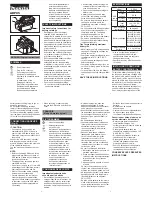
3
Always turn off the Bin Power Supply when inserting
or removing modules. The 4001/4002 has test
Points on the Power Supply control Panel to monitor
the dc voltages. When us ing the 480 outside the
4001/ 4002, ensure that the power jumper cable
used properly accounts for the Power Supply
grounding circuits provided in the recommended
standards of US DOE TID-20893 (Rev.). Both high-
quality and power-return ground connections are
provided to ensure proper reference voltage
feedback into the Power Supply, and these must be
preserved in remote installations. Care must also be
exercised to avoid ground loops when the module is
operated outside the Bin.
If the 480 should be inserted in a bin that has no ac
voltage dis t ribution, the unit will not operate since
t he relay is driven from the ac line on pins 33 and
41.
4. OPERATION
4.1. PANEL CONTROLS
Cal
A 22-turn potent iometer on the front panel
varies the output pulse height continuously over a
2. 5: 1
range
(approximately) to allow for
normalization of the Pulse Height dial setting.
Pulse Height
The Pulse Height potentiometer on
the front panel controls is the output pulse height
from zero volts to the maximum determined by the
Attenuator toggle switches and the termination load.
This 10-turn potentiometer has a calibration linearity
of ±0.25%.
Attenuators
Four toggle switches on the front
panel control pi-attenuators in the attenuated output
line; the maximum att enuation is 1000:1. These
switches have an accuracy controlled by 1% metal
film resistors and depend upon the attenuated
output being terminated in 100
Ù
.
Off/On
This front panel s lide switch allows the
internal relay to be driven from the ac line. The
frequency of the ac line will be 50 to 60 Hz.
Neg/ Pos
The Polarity of the output signal will be
either negative (-) or Positive (+) as determined by
the setting of this front panel slide switch.
4.2. INITIAL TESTING AND
OBSERVATION OF PULSE WAVEFORMS
See Section 6.1 for test performance data.
4.3. CONNECTOR DATA
CN 1
The Direct Output BNC connector provides a
dc -coupled output that looks back directly at the
relay and has an output impedance of 100
Ù
. The
output of this connector provides a constant output
voltage for a given setting of the Puls e Height
control independent of the position of the Attenuator
switches. Output voltage range is from 0 to 5 V
maximum into 100
Ù
and 0 t o 10 V into a high
impedance. The direct output may or may not be
terminated with a 100
Ù
terminator. If the direc t
output is terminated with a 100
Ù
terminator, the
decay time of the output pulse will change from a
nominal value of 400
ì
sec t o a value of 200
ì
sec.
The polarity of the Direct Output pulse will be either
negative or positive as determined by the Neg/Pos
switch.
CN 2
The Attenuated Output BNC connector
provides a dc-coupled output connector with an
output impedance of 100
Ù
. The attenuat ed output
has the At t enuators in series with it. The use of
these switches therefore alters the pulse amplitude
appearing at the attenuated output for a given
setting of the Pulse Height control. The attenuated
output should always be terminated with 100
Ù
. The
polarity of the output pulse will be determined by the
Neg/Pos switch.
TPI
An oscilloscope test point is on the front panel
for monitoring the signal on the Direct Output BNC
connector CN1. This test point has a 470
Ù
s eries
resistor connecting it to CN1.
TP2
An oscilloscope test point is also on the front
panel for monitoring the signal on Attenuated Output
Summary of Contents for ORTEC 480
Page 6: ...vi ...


































